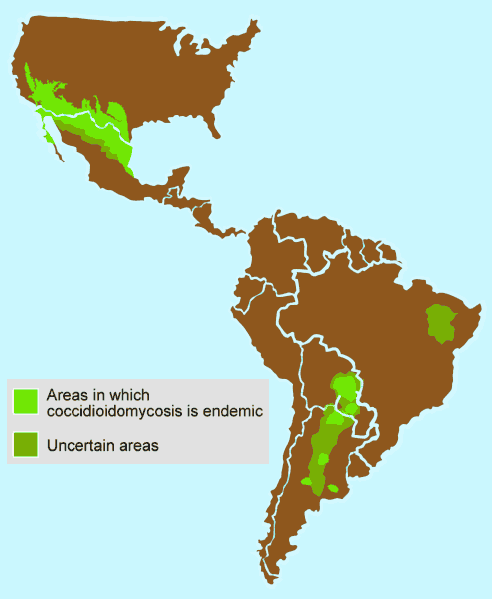Coccidioidomycosis
Template:DiseaseDisorder infobox
|
Coccidioidomycosis Microchapters |
|
Diagnosis |
|---|
|
Treatment |
|
Case Studies |
|
Coccidioidomycosis On the Web |
|
American Roentgen Ray Society Images of Coccidioidomycosis |
For patient information click here
Editor-In-Chief: C. Michael Gibson, M.S., M.D. [1]
Overview
Historical Perspective
Pathophysiology
Epidemiology & Demographics
Risk Factors
Screening
Causes
Differentiating Coccidioidomycosis
Complications & Prognosis
Diagnosis
History and Symptoms | Physical Examination | Staging | Laboratory tests | Electrocardiogram | X Rays | CT | MRI Echocardiography or Ultrasound | Other images | Alternative diagnostics
Treatment
Medical therapy | Surgical options | Primary prevention | Secondary prevention | Financial costs | Future therapies

Occurrence
California state prisons have been particularly affected by Coccidioidomycosis, as far back as 1919. In 2005 and 2006, the Pleasant Valley State Prison near Coalinga and Avenal State Prison near Avenal on the western side of the San Joaquin Valley had the highest incidence rate in 2005, of at least 3,000 per 100,000 [2].
Biological Warfare
C. immitis was investigated by the United States during the 1950s and 1960s as a potential biological weapon. The Cash strain received the military symbol OC, and original hopes were for its use as an incapacitant. As medical epidemiology later made clear, OC would have lethal effects on several segments of the population, so it was later considered a lethal agent. It was never standardized, and beyond a few field trials, it was never weaponized. Most military work on OC was on vaccines by the mid-1960s.
Diagnostic test
The fungal infection can be demonstrated by microscopic detection of diagnostic cells in body fluids, exudates, sputum and biopsy-tissue. With specific nucleotide primers C.immitis DNA can be amplified by PCR. It can also be detected in culture by morphological identification or by using molecular probes that hybridize with C.immitis RNA. An indirect demonstration of fungal infection can be achieved also by serologic analysis detecting fungal antigen or host antibody produced against the fungus.
Pathology
<youtube v=RtpvzCfFwfg/>
Popular culture
The illness is mentioned in episode Lines in the Sand of the TV Show House, as the cause of a young girl's loss of inhibition. The illness does not actually cause loss of inhibition, nor does it cause milky tears. This was not a factual error in the episode: House was tricking the girl, however this was not obvious to many viewers.
It is also the center of an episode of the TV series Bones, The Man In the Fallout Shelter. After being exposed to the fungus, the team was quarantined over Christmas to determine whether or not they had become infected. It was erroneously claimed to be contagious from person to person.
References
External links
- U.S. Centers for Disease Control and Prevention page on Coccidioidomycosis
- Medline Plus Entry for Coccidioidomycosis